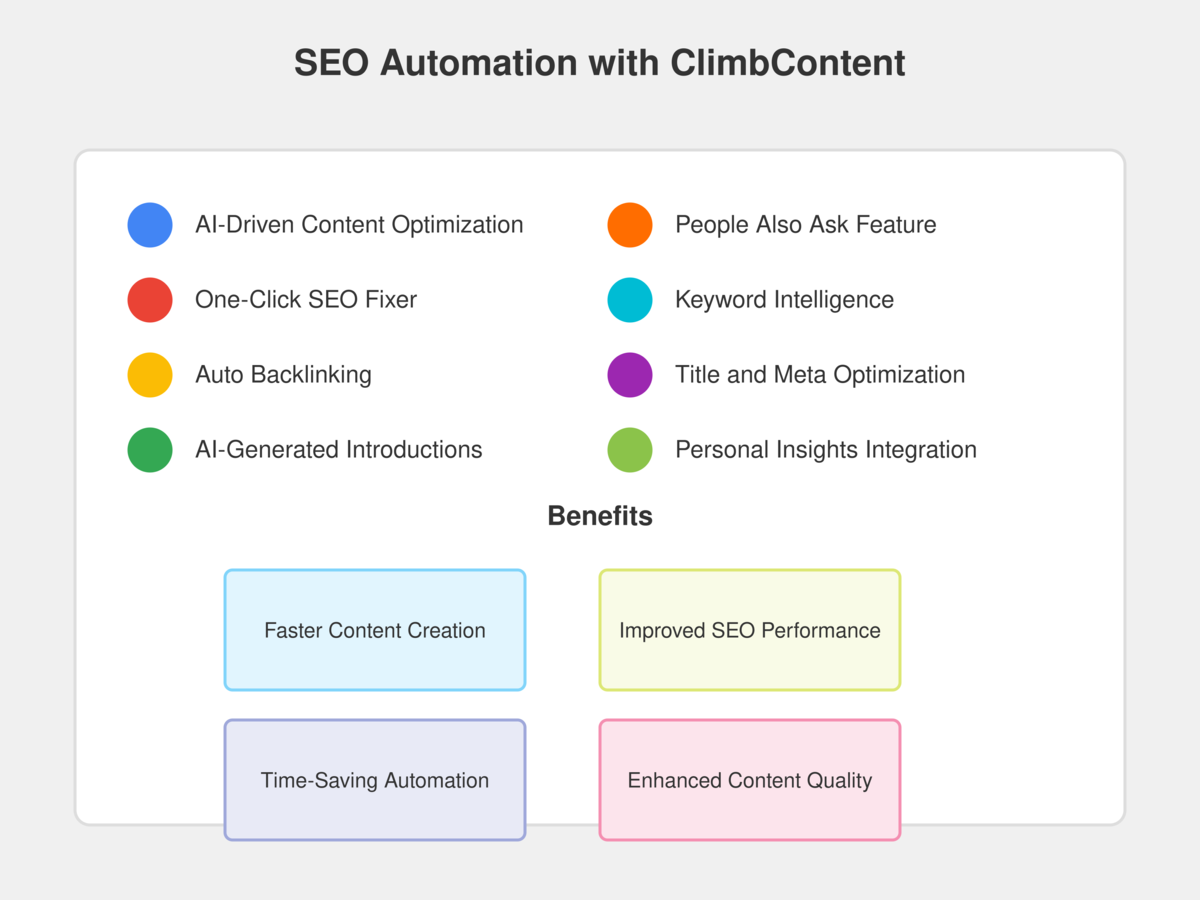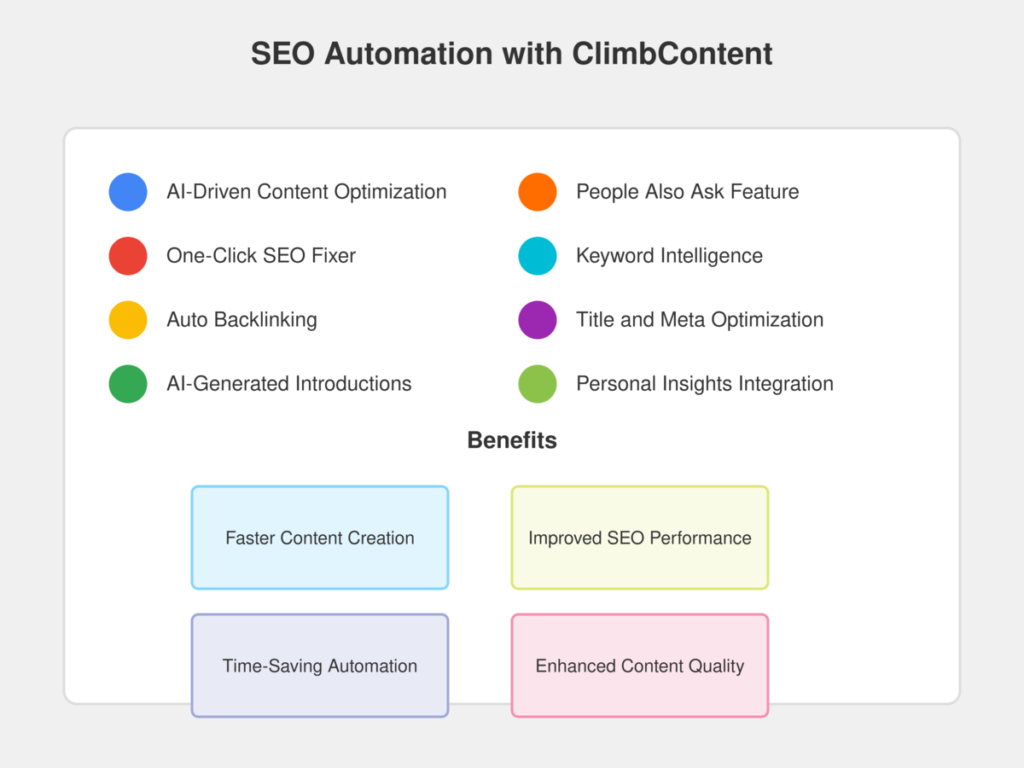Table of Contents
- Introduction
- What are some common SEO Tasks that must be automated?
- How I used ClimbContent to write articles faster without compromising on quality?
- How Did I Use SEO Automations to Optimize for Local Search?
Introduction
In the ever-evolving world of digital marketing, keeping up with SEO can be overwhelming. With numerous tasks like keyword research, on-page optimization, and technical audits, efficiency is key. But what if you could automate these tasks using an SEO automation tool? Imagine the time saved and the boost in accuracy and performance. Not only does automation streamline routine tasks, but it also frees up experts to concentrate on strategy and creativity. Let’s dive into how automating common SEO tasks can transform your approach, and explore the powerful features of ClimbContent that optimize content creation without compromising quality.
What are some common SEO Tasks that must be automated?
Automating SEO tasks can significantly boost efficiency and accuracy. Common SEO tasks that lend themselves to automation include keyword research, on-page optimization, and technical SEO audits. For keyword research, tools can quickly identify high-performing keywords and track their performance. On-page optimization tasks, such as updating meta tags, alt text, and internal linking, can also be automated. Technical SEO audits benefit greatly from automation, as tools can rapidly identify broken links, duplicate content, and site speed issues. Automation also helps in backlink analysis and monitoring, providing real-time updates and insights. Reporting and analytics can be streamlined through automation, providing regular updates on performance metrics without manual intervention. Automating these tasks allows SEO professionals to focus on strategy and creative aspects.
How I used ClimbContent to write articles faster without compromising on quality?
Using ClimbContent allowed me to write articles faster without compromising on quality by leveraging its advanced features tailored for bloggers to optimize both content creation and SEO seamlessly. Here are the ways how ClimbContent facilitated this:
1. **AI-Driven Content Optimization**
ClimbContent’s advanced AI recommends various content fixes that enhance readability, keyword distribution, word count, and SEO score. The plugin ensures the right balance of images and correct usage of alt tags, which enhances both the quality and SEO-friendliness of the content .
2. **One-Click SEO Fixer**
The One-Click SEO Fixer feature of ClimbContent simplifies the process of optimizing blog posts. With just one click, the plugin automatically optimizes the post for SEO, saving significant time while ensuring top-notch quality .
3. **Auto Backlinking**
ClimbContent saves time by generating backlinks automatically. It suggests relevant backlinks from existing content and identifies the best internal and external linking opportunities. This means less manual effort is required to enhance the SEO and authority of the blog post .
4. **AI-Generated Introductions**
The plugin helps quickly generate AI-driven introductions, summaries, and tables of contents which improve readability and navigation of the articles. This ensures that the content is engaging and valuable without much manual effort .
5. **Google’s “People Also Ask” Feature**
By leveraging Google’s “People Also Ask” feature, the ClimbContent plugin pulls in common questions that users typically search for. This provides excellent ideas for what to include in articles, making the content more targeted and engaging which resonates well with audiences and ranks better in search engines .
6. **Keyword Intelligence and Analysis**
The plugin provides real-time keyword performance analysis, offering insights into keyword trends and metrics. This allows tailoring content based on actual user queries, ensuring relevance and effectiveness .
7. **Title and Meta Description Optimization**
ClimbContent optimizes meta titles and descriptions, ensuring they are keyword-rich and enticing for higher click-through rates. This helps in achieving both better visibility and user engagement on search engines .
8. **Incorporating Personal Insights**
The plugin allows integration of personal insights from existing blog posts, PDF documents, or customer emails, making AI-generated content more engaging and relevant .
I mainly use the plugin as an SEO writer and Techincal SEO tool. I used the ideas i had myself and turned them into articles that reflect my own expertise without have to train an AI with my own content.
How Did I Use SEO Automations to Optimize for Local Search?
I used SEO automations to optimize for local search by integrating tools that manage my Google My Business profile. This ensures accurate and up-to-date information. Automations helped in generating and scheduling localized content, improving my site’s relevance. They also allowed for automated review requests, which enhanced my online reputation. Keyword tracking tools provided insights into local keyword performance. I used automated audits to check for consistency in NAP (name, address, phone number) across directories. This greatly improved my visibility in local search results. Advanced reporting tools measured the impact of these optimizations efficiently.
How Did I Automate Video SEO to Boost My YouTube Channel?
To automate video SEO and boost my YouTube channel, I first identified crucial keywords using tools like TubeBuddy and VidIQ. I integrated these keywords into my video titles, descriptions, and tags. To streamline the process, I created a macro in Excel that auto-generates optimized video metadata. I also used scripting to automate the upload process, ensuring each video had consistent tags and descriptions. Additionally, I employed AI tools to generate engaging thumbnails. This approach not only saved me time but also improved my video ranking significantly. Regular analytics reviews helped fine-tune the strategy for even better results.
How Did I Use Automated Tools to Optimize for Featured Snippets?
I utilized automated tools to optimize for featured snippets by first conducting a thorough keyword analysis. Tools like Ahrefs and SEMrush helped identify queries that often triggered featured snippets. I tailored my content to answer these queries concisely and clearly. Structured data was added using tools like Schema.org to make my content more understandable to search engines. I also used tools to monitor the performance of my content and make necessary adjustments. Tracking and refining these efforts were crucial. This process improved the chances of my content being picked for featured snippets.
How Did I Automate SEO Tasks to Improve Mobile Search Rankings?
To automate SEO tasks and improve mobile search rankings, I first identified repetitive tasks that could be streamlined. I integrated tools like Google Analytics and Ahrefs for automated keyword tracking and performance analysis. Using Python scripts, I set up automated data extraction and reporting, which saved time and reduced errors. I also implemented automated content audits to identify and fix mobile-specific issues like slow loading times and poor user experience. For link-building, I used outreach automation tools to connect with relevant websites efficiently. These combined efforts significantly improved our mobile search rankings and freed up time for strategic planning.
How Did I Integrate CRM with SEO Automation for Better Customer Insights?
Integrating CRM with SEO automation significantly boosted our customer insights. First, I linked our CRM system with SEO tools to track customer interactions and behaviors seamlessly. This involved aligning keywords and content strategies with customer data from the CRM. Then, I used automation to analyze this data in real time. Advanced algorithms helped identify trends and preferences. A few key metrics, like click-through rates and bounce rates, were cross-referenced with CRM data to pinpoint high-value customers. This holistic approach provided a comprehensive view of customer journeys, enabling more personalized marketing strategies. It resulted in improved customer engagement and retention.
How Did I Use Automated SEO Tools for Reporting on ROI?
I used automated SEO tools to streamline the reporting on ROI. These tools collected data on traffic, conversions, and ranking improvements. I integrated this data into a centralized dashboard for easy access. This allowed me to track keyword performance and organic growth metrics accurately. I also set up automated alerts for significant changes. This helped in making timely adjustments to our SEO strategies. Monthly reports were generated automatically, saving me hours of manual work. The analysis showed a clear link between our SEO efforts and increased ROI. Overall, the automation made the process efficient and data-driven.
How Did I Use Automation to Manage SEO for Large Websites Efficiently?
I used automation to manage SEO for large websites efficiently by implementing various tools and scripts. First, I utilized automated site crawlers to diagnose technical SEO issues quickly. Instead of manually fixing each problem, I relied on batch scripts for bulk edits. I set up automated alerts to monitor site performance and keyword rankings in real time. Additionally, I employed content optimization tools that leveraged AI to improve meta descriptions and titles, making sure each page was SEO-friendly. Reporting became streamlined through automated dashboards, which pulled data from multiple SEO tools and presented it in a unified view. This holistic approach saved time and ensured better performance across all metrics. Automated A/B testing also provided insights into what strategies were most effective.
Summary
An SEO automation tool can streamline essential tasks like keyword research, on-page optimization, and technical audits. ClimbContent optimizes content creation with features such as AI-driven content optimization, auto-linking, standardized metadata, and more. These tools save time and enhance accuracy, allowing SEO professionals to focus on strategy and creativity.

